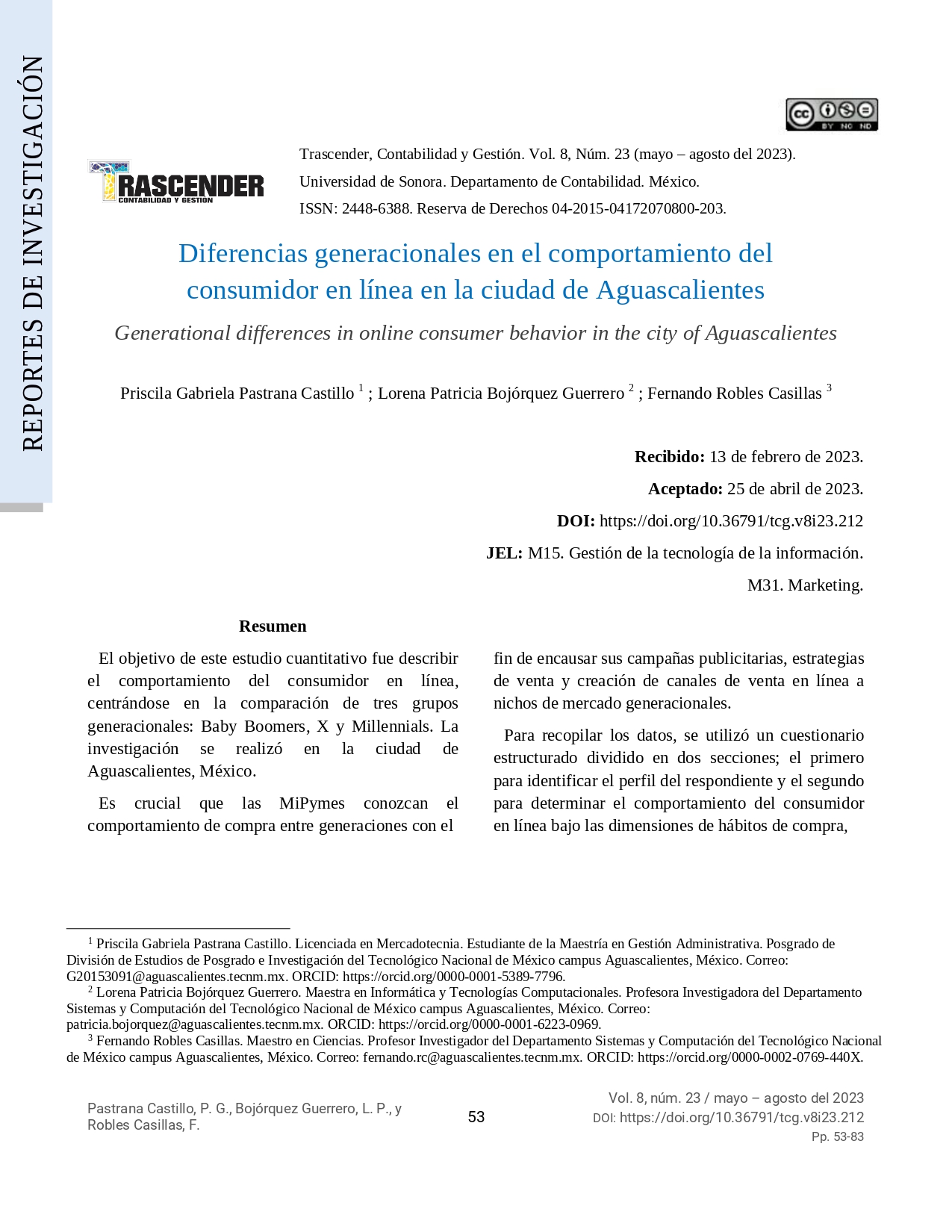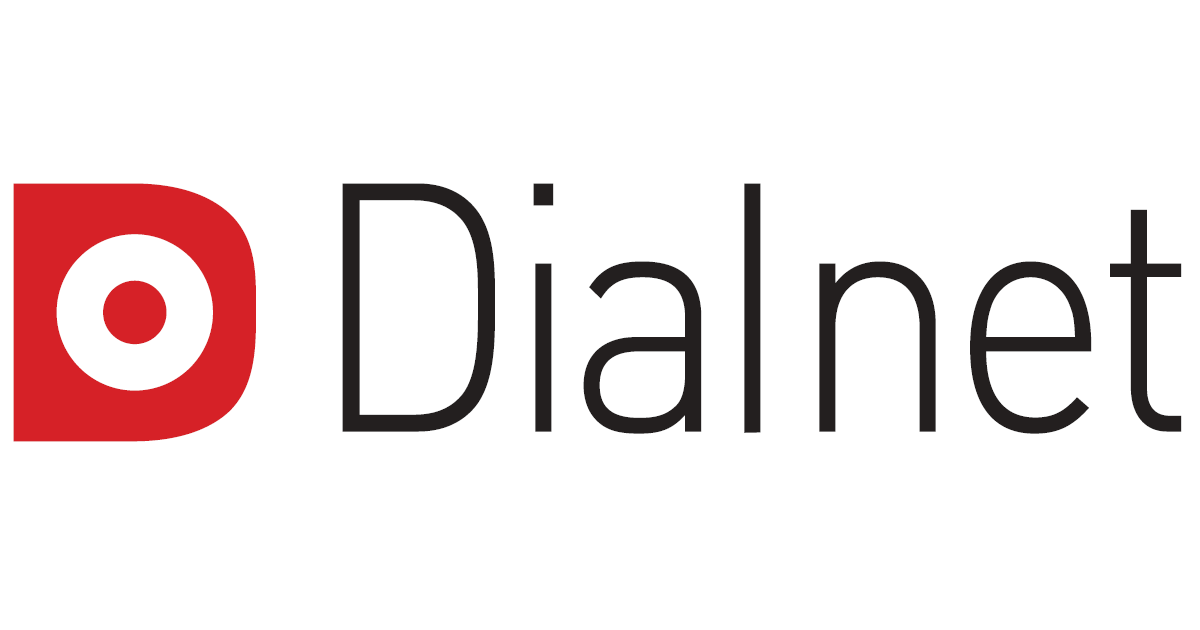Generational differences in online consumer behavior in the city of Aguascalientes
DOI:
https://doi.org/10.36791/tcg.v8i23.212Keywords:
Generations, online shopping, consumer behaviorAbstract
The primary objective of this quantitative study was to provide a comprehensive depiction of online consumer behavior, with a particular focus on comparing three distinct generational cohorts: Baby Boomers, Generation X, and Millennials. The investigation was conducted within the confines of Aguascalientes, Mexico.
It emphasized the importance for small and medium- sized enterprises (SMEs) to understand intergenerational purchasing behavior in order to tailor
advertising campaigns, sales strategies, and online sales channels to generational market segments.
To facilitate the data collection process, a meticulously structured questionnaire, comprising two
distinct sections: The primary aim is to determine the profile of the respondent, while the secondary aim is to investigate online consumer behavior across multiple dimensions, encompassing purchasing habits, purchase motivators, purchasing platforms, acquired products,
purchase intentions, and consumer satisfaction, was employed. The sample size encompassed 384 participants, of whom 166 abstained from engaging in
online purchases. Consequently, the remaining 218 respondents, who had executed at least one online transaction, were deemed as valid subjects suitable for evaluating online consumer behavior. The findings underscore the fact that all three
generational groups display a proclivity towards selecting specific dates and domestic online platforms
for their purchasing activities. Millennials, owing to their heightened comprehension of the digital landscape, demonstrate a more pronounced inclination towards this medium. Remarkably, notable variations between the cohorts were observed across all facets examined, as each generation experienced distinct levels of exposure to technology throughout different life stages.
Downloads
References
Asociación Mexicana de Venta Online. (2022). Estudio sobre venta online 2022. Ciudad de México. Recuperado de https://www.amvo.org.mx/estudios/estudio-sobre-venta-online-en-mexico-2022/
Chen, Y.-H., Tsao, C.-Y., Lin, C.-C., y Hsu, I.-C. (2008). A Conjoint Study of the Relationship between Website Attributes and Consumer Purchase Intentions. 224.
Díaz-Sarmiento, C., López-Lambraño, M., y Roncallo- Lafont, L. (2017). Entendiendo las generaciones: una revisión del concepto, clasificación y características distintivas de los Baby Boomers, X Y Millennials. Clío América, 11(22). https://doi.org/10.21676/23897848.2440 DOI: https://doi.org/10.21676/23897848.2440
Dimock, M. (2019). Defining generations: Where Millennials end and Generation Z begins. Pew Research Center, 17(1), 1-7.
Dini, M., Gligo, N., y Patiño, A. (2021). Transformación digital de las mipymes: elementos para el diseño de políticas (p. 61). Santiago de Chile: CEPAL. Recuperado de
https://www.cepal.org/es/publicaciones/47183-transformacion-digital-mipymes-elementos diseno-politicas
Fernández, L. (2014). El comportamiento del consumidor online. Factores que aumentan la actividad de búsqueda de eWOM en el Sector Turístico (p. 141). Oviedo: Universidad de
Oviedo. Recuperado de http://hdl.handle.net/10651/29594
Flavián Blanco, C., y Guinalíu Blasco, M. (2007). Un análisis de la influencia de la confianza y del riesgo percibido sobre la lealtad a un sitio web. El caso de la distribución de servicio gratuitos (pp. 159–178). Zaragoza: Universidad de Zaragoza. Recuperado de
https://dialnet.unirioja.es/descarga/articulo/2336194.pdf
Fournier, S., y Glen Mick, D. (1999). Rediscovering Satisfaction (pp. 159–178). Journal of Marketing. Recuperado de https://doi.org/10.1177/002224299906300403. DOI: https://doi.org/10.1177/002224299906300403
Hwang, Y., y Jeong, J. (2016). Electronic commerce and online consumer behavior research: A literature review. In Information Development (Vol. 32, Issue 3, pp. 377– 388). SAGE Publications Ltd. https://doi.org/10.1177/0266666914551071 DOI: https://doi.org/10.1177/0266666914551071
INEGI. (2021). Población de Aguascalientes Censo 2020.
INEGI. (2022). Encuesta Nacional sobre Disponibilidad y Uso de tecnologías de la Información de los Hogares. https://www.inegi.org.mx/programas/dutih/2021/#Informacion_general
Instituto Federal de Telecomunicaciones. (2019). Uso de las TIC y actividades por internet en México. https://www.ift.org.mx/sites/default/files/contenidogeneral/estadisticas/usodeinternetenmex co.pdf
Izquierdo Yusta, A., y Martínez Ruiz, M. P. (2009). Análisis de los factores que condicionan la elección del canal de compra por parte del consumidor evidencias empíricas en la industria hotelera (pp. 93–122). España: Cuadernos de economía y dirección de la empresa. Recuperado de https://doi.org/10.1016/S1138-5758(09)70049-0 DOI: https://doi.org/10.1016/S1138-5758(09)70049-0
Kim, D. J., Ferrin, D. L., y Rao, H. R. (2008). A trust-based consumer decision-making model in electronic commerce: The role of trust, perceived risk, and their antecedents. Decision Support Systems, 44(2), 544–564. https://doi.org/10.1016/j.dss.2007.07.001 DOI: https://doi.org/10.1016/j.dss.2007.07.001
Kotler, P., y Keller, K. L. (2012). Dirección de Marketing (p. 151-160). Ciudad de México: Pearson Educación. Ciudad de México: Pearson Educación. KPMG International. (2017). The truth about online consumers (p. 40). Amstelveen: KPMG International.
Kukafka, R., Johnson, S. B., Linfante, A., y Allegrante, J. P. (2003). Grounding a new information technology implementation framework in behavioral science: A systematic analysis of the literature on IT use. In Journal of Biomedical Informatics (Vol. 36, Issue 3, pp. 218–227).
Academic Press Inc. https://doi.org/10.1016/j.jbi.2003.09.002 DOI: https://doi.org/10.1016/j.jbi.2003.09.002
Labti, O., y Belkadi, E. (2020). Comportement du consommateur en ligne: revue de littérature. Revue Internationale Des Sciences De Gestion, 2(4). Recuperado de https://revueisg.com/index.php/home/article/view/173
Leccardi, Carmen, y Feixa, Carles. (2011). El concepto de generación en las teorías sobre la juventud. Ultima década, 19(34), 11-32. https://dx.doi.org/10.4067/S0718-22362011000100002 DOI: https://doi.org/10.4067/S0718-22362011000100002
Li, H., Kuo, C., y Russell, M. (1999). The impact of perceived channel utilities, shopping orientations, and demographics on the consumer’s online buying behaviour. Journal of Computer Mediated Communications. https: 10.1111/j.1083- 6101.1999.tb00336.x
Ling, K., Lau, T.-C., y Piew, T. (2010). The Effects of
Shopping Orientations, Online Trust and Prior Online
Purchase Experience toward Customers’ Online
Purchase Intention. International Business Research, 3.
https://doi.org/10.5539/ibr.v3n3p63 DOI: https://doi.org/10.5539/ibr.v3n3p63
López-Piñón, D. C., y Terán-Cazares, M. M. (2020).
Análisis de los factores que influyen en la intención de
compra online (pp. 1377–1385). Monterrey:
Universidad Autónoma de Nuevo León. Monterrey:
Universidad Autónoma de Nuevo León.
Moliner Velázquez, B., Berenguer Contrí, G., y Gil
Saura, I. (2001). La importancia de la performance y
las expectativas en la formación de la satisfacción del
consumidor.
Parra, M. C. (2006). La Insatisfacción del Consumidor y
las Respuestas ante la Insatisfacción: un Análisis
Teórico y Empírico [Tesis de doctorado, Universidad
Católica San Antonio]. Recuperado de
http://hdl.handle.net/10952/242
Peña, N. (2020). Factores Motivacionales y
Comportamiento del Consumidor Online: Una
aproximación cross-cultural [Tesis de doctorado,
Universidad de Valencia]. Roderic. Recuperado de
http://hdl.handle.net/10550/56679
Pew Research Center. (2014). Millennials in Adulthood.
National Food Policy Conference, Washington, D.C.
United States.
Prensky, M. (2001). Digital natives, digital immigrants’ DOI: https://doi.org/10.1108/10748120110424816
part 1. On the horizon, 9(5), 1-6.
PWC. (2011). Millennials at work Reshaping the
workplace. Recuperado de
https://www.pwc.com/co/es/publicaciones/assets/mille
nnials-at-work.pdf
Quirós Padilla, D. (2019). El consumidor digital:
motivaciones y factores que influencian su
comportamiento. (Trabajo Fin de Grado Inédito).
Universidad de Sevilla, Sevilla.
Ríos, A. (2014). Análisis y perspectivas del comercio
electrónico en México. Enl@ce Revista Venezolana de
Información, Tecnología y Conocimiento, 11 (1), 97-
Schiffman, L. G., y Wisenblit, J. (2015).
Comportamiento del consumidor.
https://www.academia.edu/45186428/Comportamiento
_del_Consumidor_11va_Edic_Leon_Schiffman_y_Wis
enblit
Statista. (2022). Distribución de los usuarios de internet
que compraron algún producto en línea en México en
, por región.
https://es.statista.com/estadisticas/1115170/mexico-
porcentaje-usuarios-ecommerce-region/
Vereinte Nationen, Konrad-Adenauer-Stiftung, y Inter-
American Development Bank. (2021). Post pandemic
COVID-19 economy recovery enabling Latin America
and the Caribbean to better harness e-commerce and
digital trade.
Yao, P., Osman, S., Sabri, M. F., y Zainudin, N. (2022).
Consumer Behavior in Online-to-Offline (O2O)
Commerce: A Thematic Review. Sustainability,
(13), 7842. https://doi.org/10.3390/su14137842 DOI: https://doi.org/10.3390/su14137842
Zemke, R., Raines, C., y Filipczak, B. (2013).
Generations at work: Managing the clash of boomers,
gen xers, and gen yers in the workplace (2a ed.).
Amacom.

Downloads
Published
How to Cite
Issue
Section
License
Copyright (c) 2023 Priscila Gabriela Pastrana Castillo

This work is licensed under a Creative Commons Attribution-NonCommercial-NoDerivatives 4.0 International License.
La Revista Trascender, Contabilidad y Gestión se compromete a asegurar la confidencialidad y privacidad dela información personal que se capture en éste sistema de conformidad con los lienamientos editoriales de la Universidad de Sonora
La información será utilizada únicamente para fines editoriales, académicos y de investigación, notificándose de forma directa al usuario registrado en el sistema, con el alcance que el usuario establezca al momento de su registro.
























